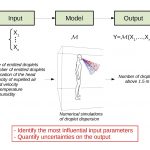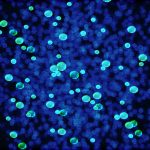Team seminar
2024
October 1st, Seminar by Long Li
- When: Tuesday, October 1st 2024 at 10:30 (CET)
- Where: Coriolis (Galois building)
- Speaker: Long Li (Inria, Rennes)
- Topic: Stochastic Modeling in Geophysical Fluid Dynamics
- Abstract: My research focuses on stochastic modeling in geophysical fluid dynamics, with applications such as uncertainty quantification and ensemble forecasting. Accurate simulations of the ocean and atmosphere are crucial for understanding climate patterns. These simulations involve many interacting scales, but to keep computational time reasonable, we typically simulate only large-scale flows. However, it is essential to account for the effects of uncertainties and smaller scales to minimize errors and provide a reliable set of likely realizations. In this work, we employ a specific stochastic method based on mathematical and physical principles. We tested this method in several mesoscale models and calibrated it using reference data. The models we developed accurately represent large-scale flow statistics while effectively balancing model error and ensemble spread. This stochastic method also helps explain interactions between possibly intermittent wind, waves, and currents by incorporating uncertainty from smaller scales. Our tests demonstrate that the model captures complex dynamics more accurately and represents uncertainty more effectively. Furthermore, this stochastic framework provides a new family of models to represent physical phenomena. These results are significant for the future development of ocean and climate models.
June 6th, Seminar by Alexis Anagnostakis and Thomas Rey
- When: Thursday, June 6th 2024 at 10:00 (CET)
- Where: Coriolis (Galois building)
- Speakers:
- Alexis Anagnostakis (Univ. Grenobles Alpes, France)
- Thomas Rey (LJAD Nice, France)
- Topics:
- Approximation of the local time of a sticky diffusion and applications
- An overview of the granular gas equation: modeling, theoretical and numerical analysis
- Abstract:
- We show that the local time of a sticky diffusion can be approximated by certain kind of high-frequency path statistics. This generalizes results of Jacod for smooth diffusions. We prove various form of the result that depend on the type of normalizing sequence we use. We then use the result to:devise a consistent stickiness parameter estimator,assess the behavior of number of crossing statistics,(if time allows) assess the convergence rate of discrete-time hedging strategies in a “sticky Black-Scholes model”.
- Over the last 20 years, kinetic descriptions of granular materials have received much attention from the mathematical community, as well as from more applied disciplines such as physics and engineering. Nevertheless, many mathematical problems are still open, whether at the level of modeling, analysis, or numerical simulations of these models.
The aim of this talk is to present some of these models, as well as (very) recent mathematical results on the subject… We will also discuss recent numerical developments that have led to the formulation of still open conjectures.
April 18th, Seminar by Rémi Catellier
- When: Thursday, April 18th 2024 at 10:00 (CET)
- Where: Coriolis (Galois building)
- Speaker: Rémi Catellier (LJAD Nice, France)
- Topic: Some aspects of regularization by noise
- Abstract: Some quite classical PDEs or ODEs may be ill-posed, whereas the adding some (random) noise to the considered systems may allow to retrieve existence and uniqueness of solutions. I will present different situations in which such a phenomenon may happen : ODE with additive noise, Stochastic heat equation with additive noise and rough differential equations. I will emphasis the now quite standards (commons) techniques to deal with such questions in those different settings, and give some results.
April 15th, Seminar by Jessie Levillain
- When: Monday, April 15th 2024 at 14:00 (CET)
- Where: Coriolis (Galois building)
- Speakers:
- Jessie Levillain (CMAP Ecole Polytechnique, Palaiseau, France)
- Siddhartha Mukherjee (LJAD, Nice, France)
- Topics:
- Understanding flagellar curvature: mathematical models of activation mechanisms
- The nature of living fluid turbulence
- Abstracts:
- Many micro-swimmers in nature achieve locomotion via active appendages-like organelles such as cilia or flagella, when moving inside fluids at a low Reynolds number. In order to swim as efficiently as possible in viscous fluids, these cilia and flagella all have a characteristic periodic motion. However, this motion cannot be easily reproduced when studying a simple elastic filament without any form of activation along is length as, in this case, the wave propagating along the swimmer is attenuated very quickly, contrarily to the behaviors observed in the tails of swimming micro-organisms in biology.
We aim to explain how to take into account the complex structure of the biological flagellum and in particular its influence on the tail’s oscillating pattern. We focus on these flagellar activation mechanisms, from a mathematical point of view, both theoretically and numerically. - Active turbulence is a confounding flow state emerging spontaneously in living fluids at the micro-scale. We shall ask which aspects of these flows echo the behaviour of large-scale inertial turbulence, and what sets living flows apart from the inanimate.
March 21st, Seminar by Łukasz Mądry
- When: Thursday, March 21st 2024 at 11:30 (CET)
- Where: Coriolis (Galois building)
- Speaker: Łukasz Mądry (Cerema, Paris Dauphine, France)
- Topic: Selection problem for singular SDEs
- Abstract: I will present recent results obtained in my PhD supervised by Paul Gassiat on the zero noise limits (also called the selection problem) of the system given by the SDE: dx = b(x) dt + \eps dw. In this equation, b is a singular power law function b(x) = sign(x) |x|^γ and w is fractional Brownian motion with Hurst exponent H. We prove that the solution converges to the extremal solution t^{1/(1-γ)} in the full range of Catellier-Gubinelli setting γ > 1 – 1/(2H), with sub-exponential concentration rates. I will present our results in a simple case, where x is one particle and then present some partial results in the case of interacting particle systems with a repulsive singular interaction kernel, where we observe particle dispersion..
March 7th, Seminar by Juliane Klamser
- When: Thursday, March 7th 2024 at 10:00 (CET)
- Where: Coriolis (Galois building)
- Speaker: Juliane Klamser (CNRS, Lab. Charles Coulomb, Université de Montpellier, France)
- Topic: Active matter in two parts. Part 1: Emerging mesoscale flows and chaotic advection in dense active matter. Part 2: Capturing active matter dynamics in Monte Carlo simulations.
- Abstract: This presentation will have two parts dealing with different aspects of simple models of active matter, namely self-propelled point particles. The first part will concentrate on emerging collective phenomena and the second part will focus on alternative ways to simulate these systems. —— Part 1 —— The collective phenomena emerging for sterically interacting self-propelled point particles in two space dimensions are rich and have thus been subject of intense research. Despite the intense focus on these systems considered as the simplest kind of active matter, we have not yet discovered all the physics. I will show that mesoscale flows with chaotic advection that phenomenologically resemble turbulence emerge at high densities when these self-propelled particles are very persistent. The existence of these collective flows is surprising because the self-propulsion forces have no spacial correlations, thus the flows emerge from a competition of crowding at high densities and persistent forcing on the level of individual particles. Introducing a small degree of additional alignment interactions between the self-propulsion forces of closeby particles does not change the qualitative and quantitative features of the chaotic flows thus suggesting some kind of universality. —— Part 2 —— The physics of active matter is determined by the non-equilibrium dynamics of individual particles. Therefore, numerical studies largely rely on the integration of the equation of motion, i.e. Langevin simulations. However, a small number of publications have used kinetic Monte Carlo approaches to study collective behaviours of persistently moving particles in continuous space. Here, I will bridge the gap between these two a priori different dynamics and show that Monte Carlo approaches can indeed faithfully capture active matter physics.
January 18th, Seminar by Jérémy Zurcher
- When: Thursday, January 18th 2024 at 14:00 (CET)
- Where: Coriolis (Galois building)
- Speaker: Jérémy Zurcher (Université de Lille, France)
- Topic: Spatial Sojourn Time of Stochastic Wave Equation
- Abstract: We consider in this talk the 1D linear stochastic wave equation, whose solution is taken in the mild sense. We are interested in the spatial sojourn time associated. We fix the time, a level \lambda and an observation window A > 0. Then the spatial sojourn time is the length of the subset of [-A, A] where the solution at time t is above the level \lambda. In 2013, Pham proved in On The Rate Of Convergence For Central Limit Theorems Of Sojourn Times Of Gaussian Fields that this process converges in law toward a Gaussian random variable when the window observation A goes to infinity, using tools from Stein-Malliavin method. Our work with C. A. Tudor is still to prove convergence theorem, but when the time t does depend on A, in particular in a polynomial dependence. We proved that no matter the polynomial dependence between t and A, the spatial sojourn time still converges in distribution as A goes to infinity, but not necessarly to a Gaussian random variable. We can moreover, thanks to the Stein-Malliavin theory, estimate the rate of convergence.
2023
Archives of 2023 seminars
2022
Archives of 2022 seminars
2021
Archives of 2021 seminars
2020
Archives of 2020 seminars





